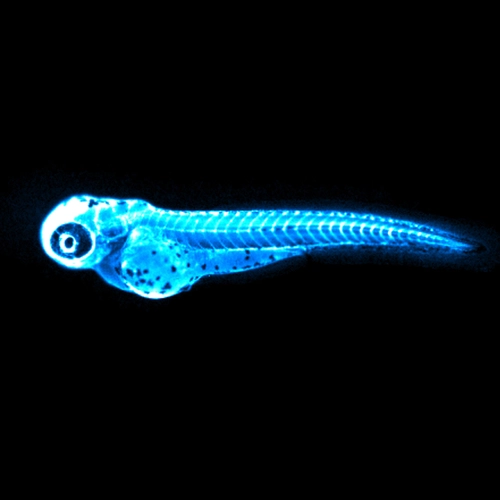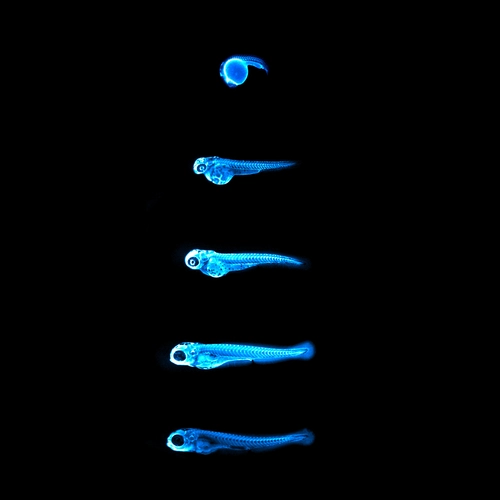Research
The Farber Lab studies lipid-modifying and transport processes in the developing 6-day-old zebrafish larvae. While the zebrafish has been established as a powerful model for the study of early development, few researchers have taken advantage of the accessibility and optical clarity of the embryos and larvae to visualize lipid uptake and processing in vivo.
Cells require lipids for the production of signaling molecules, membrane components, and as sources of fuel. Given their utmost necessity for proper cellular function, it is not surprising that defects in lipid metabolism underlie a number of human diseases, including obesity, diabetes, and atherosclerosis. In 2007-08, one-third of US adults and >18% of children (ages 6-19) were classified as obese, with obesity and type 2 diabetes on the rise worldwide. The globalization of the high-fat Western diet and the concurrent rise in the incidence of lipid disorders has provided an impetus to better understand lipid metabolism in the context of metabolic dysfunction.
This need to investigate the role of lipids in metabolic disease has also brought into focus questions that remain unanswered in the field. For instance, although the genes involved in cholesterol and fatty acid (FA) uptake in intestinal cells have been identified, their exact mechanisms of action are highly debated or largely unknown. Such gaps in our understanding of these genes and how they function hinder the development of effective therapeutics for lipid disorders and reveal a need to create better approaches to address them.
Current Themes
The uptake and efflux of sterol is tightly regulated at the cellular and organismal level by multiple mechanisms. While it is well established that the intestine is the primary site of dietary cholesterol absorption, the mechanisms involved in the vectorial transport of cholesterol across the intestinal epithelium are poorly understood. A better understanding of these mechanisms of sterol transport may have direct translational impact on developing treatment strategies for addressing diet-induced obesity, diabetes and cardiovascular disease.
We have developed an approach using larval zebrafish to visualize lipid uptake and processing in live intestinal enterocytes at the subcellular level. We developed a high-fat diet and used fluorescent lipids to track lipid processing within the absorptive cells of the intestine. We found that different dietary lipids sorted into distinct compartments; lipid droplets for fatty acids and endosomes for cholesterol. These data clearly implicate endosomal trafficking as a key component of dietary cholesterol uptake, something only suggested by cultured cell studies.
Following a high lipid meal, larval metabolic function can be assessed by tracking BODIPY-labeled fatty acids as they accumulate throughout numerous organs and tissues, including intestinal enterocytes and liver hepatocytes. The Farber lab has developed techniques to visualize these fatty acids in real time using confocal microscopy. The importance of this approach is that these larvae are live and we are imaging sub-cellular structures within a living organ in the presence of bile, mucus, and symbiotic organisms. While a major function of enterocytes is to absorb dietary lipids, little data exists about the subcellular trafficking kinetics of fatty acids in live animals. Our confocal microscopy studies indicate that feeding larvae a lipid-rich meal containing BODIPY-fatty acids can be a powerful tool to study fatty acid metabolism.
The vertebrate genome contains a predicted 30,000 genes many of which with unknown function. The recent development of a variety of gene knockdown technologies in zebrafish has opened the door to the genome-wide assignment of function based on the publicly available genome sequence of this model vertebrate. This effort explores the molecular mechanisms that control fundamental vertebrate embryonic processes of patterning and organ formation, biological problems in which cell-cell communication is critical during development, and digestive physiology. My lab is part of a multi-center consortium to systematically assign the biological function to a set of 100-200 putative secreted proteins by a variety of targeted approaches.
Genetic analysis in zebrafish is a powerful tool for identifying genes that direct vertebrate development. Screening methods that employ fluorescent lipids as optical biosensors of specific biochemical processes can identify mutations that perturb lipid metabolism. By applying these reagents to mutagenized zebrafish larvae, we have identified a number of mutants. One mutant, fat-free, whose digestive system appears morphologically normal yet has impaired digestive lipid processing is the focus of our most intensive efforts (Science, 2001, 292:1385-1388). We eventually succeeded in the positional cloning of the fat-free locus to find that it encodes a hypothetical protein that has no known function. New data indicates that the fat-free protein is involved in the endoplasmic reticulum - Golgi trafficking.
Together with Dr. Jamie Shuda, I have created a Science Outreach Program, Project BioEYES, that incorporates life science and laboratory education using zebrafish. The outreach program has two main components: educating students and community members through hands-on tours of a Zebrafish Facility, and bringing the zebrafish to 4-12th grade classrooms for hands-on experiments. The program teaches students about science literacy, genetics, the experimental process and the cardiovascular system through the use of live zebrafish.
The mission of the Science Outreach Program is to foster an enthusiasm for science education, promote interest for future participation in a biology-related field, and allow all students the opportunity to learn life science through a hands-on, student-centered approach to instruction. The goals of the program encompass educating the community about life science and incorporating live research as the primary teaching tool. We provide our services to all students and teachers regardless of community, poverty or race. Project BioEYES is currently serving children in Philadelphia, Baltimore, Lehigh and Notre Dame public and private school districts
This program has garnered significant excitement among primary school faculty in the region and the scientific press. Since we began, approximately 100,000 students have participated in our in-class zebrafish unit














